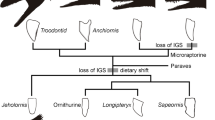Summary
The radular teeth are secreted at the posterior end of the radular gland and move slowly towards the buccal cavity where they start to function. Helix pomatia and Limax flavus were examined to determine whether the newly formed teeth already show their definite species specific shape, or whether they are gradually finished and moulded in the radular gland. Scanning electron micrographs of Helix pomatia show that teeth are secreted in the odontoblast region in their final form. Their surface is still uneven at the outset; the same is true for the newest teeth of Limax flavus. Older teeth ready for use have a smooth surface. This change seems to be brought about by secretory activity of the superior epithelium of the radular sac. Air-dried radulae, previously isolated by KOH maceration, show considerable artefacts at their posterior end. Maceration leads to shrinking of the newest teeth, but does not change their contours. The newly secreted but as yet unhardened teeth become greatly deformed during the drying process.
Similar content being viewed by others
References
Endean, R., Duchemin, C.: The venom apparatus of Conus magus. Toxicon 4, 275–284 (1967)
Kerth, K.: Radula-Ersatz und Zähnchenmuster der Weinbergschnecke im Winterhalbjahr. Zool. Jb. Anat. 88, 47–62 (1971)
Kerth, K., Hänsch, D.: Zellmuster und Wachstum des Odontoblastengürtels der Weinbergschnecke Helix pomatia L. Zool. Jb. Anat. 98, 14–28 (1977)
Kerth, K., Krause, G.: Untersuchungen mittels Röntgenbestrahlung über den Radula-Ersatz der Nacktschnecke Limax flavus L. Wilhelm Roux Archiv, 164, 48–82 (1969)
Kraus, U.: Lichtmikroskopische Untersuchungen zur Radulabildung der Wellhornschnecke Buccinum undatum L. Zulass. Arbeit am Zool. Inst. Univ. Würzburg, (1975), unpublished
Märkel, K.: Bau und Funktion der Pulmonaten-Radula. Z. wiss. Zool. 160, 213–289 (1958)
Menzel, R.: Autoradiographische Untersuchungen mit 35-S-Natriumsulfat über den Ersatz der Radula in Abhängigkeit von der Temperatur bei Helix pomatia L. (Gastropoda). Zool. Jb. Anat. 97, 550–565 (1976)
Mischor, B.: Bildung und Abbau der Radula von Pomacea bridgesi diffusa Blume (Gastropoda, Prosobranchia). Verh. Dtsch. Zool. Ges. Erlangen 1977, 282. Stuttgart: Fischer 1977
Peters, W.: Occurence of chitin in Mollusca. Comp. Biochem. Physiol. 41, (B) 541–550 (1972)
Runham, N.W.: The histochemistry of the radula of Patella vulgata. Quart. J. Micr. Sci. 102, 371–380 (1961)
Runham, N.W.: The histochemistry of the radulas of Acanthochiton communis, Lymnaea stagnalis, Helix pomatia, Scaphander lignarius and Archidoris pseudoargus. Ann. Histochim. 8, 433–442 (1963a)
Runham, N.W.: A study of the replacement mechanism of the pulmonate radula. Quart. J. Micr. Sci. 104, 271–277 (1963b)
Runham, N.W.: Alimentary canal. In Fretter, V., Peake, J.eds Pulmonates Vol. I 53–104 London, New York, San Francisco, Academic Press 1975
Runham, N.W., Thornton, P.R., Shaw, D.A., Wayte, R.C.: The mineralization and hardness of the radular teeth of the Limpet Patella vulgata. L. Z. Zellforsch. 99, 608–626 (1969)
Shimek, R.L.: The morphology of the buccal apparatus of Oenopota levidensis (Gastropoda, Turridae). Z. Morph. Tiere 80, 59–96 (1975)
Sick, E.: Bau und Bildung von Kiefer und Radula bei Gastropoden insbesondere auf Grund von histochemischen Untersuchungen. Inaug. Diss. Tübingen (1958), unpublished
Wiesel, R., Peters, W.: Licht- und elektronenmikroskopische Untersuchungen am Radulakomplex und zur Radulabildung von Biomphalaria glabrata Say (= Australorbis gl.) (Gastropoda, Basommatophora) Zoomorphologie, 89, 73–92 (1978)
Wohlfarth-Bottermann, K.E.: Die Kontrastierung tierischer Zellen und Gewebe im Rahmen ihrer elektronenmikroskopischen Untersuchungen an ultradünnen Schnitten. Naturwissenschaften 44, 287–288 (1957)
Author information
Authors and Affiliations
Additional information
The author is very much indebted to Prof. L. Schneider for his help on the SEM. The SEM and the Balzers equipment were kindly supplied by the Deutsche Forschungsgemeinschaft
Rights and permissions
About this article
Cite this article
Kerth, K. Electron microscopic studies on radular tooth formation in the snails Helix pomatia L. and Limax flavus L. (Pulmonata, Stylommatophora). Cell Tissue Res. 203, 283–289 (1979). https://doi.org/10.1007/BF00237242
Accepted:
Issue Date:
DOI: https://doi.org/10.1007/BF00237242




